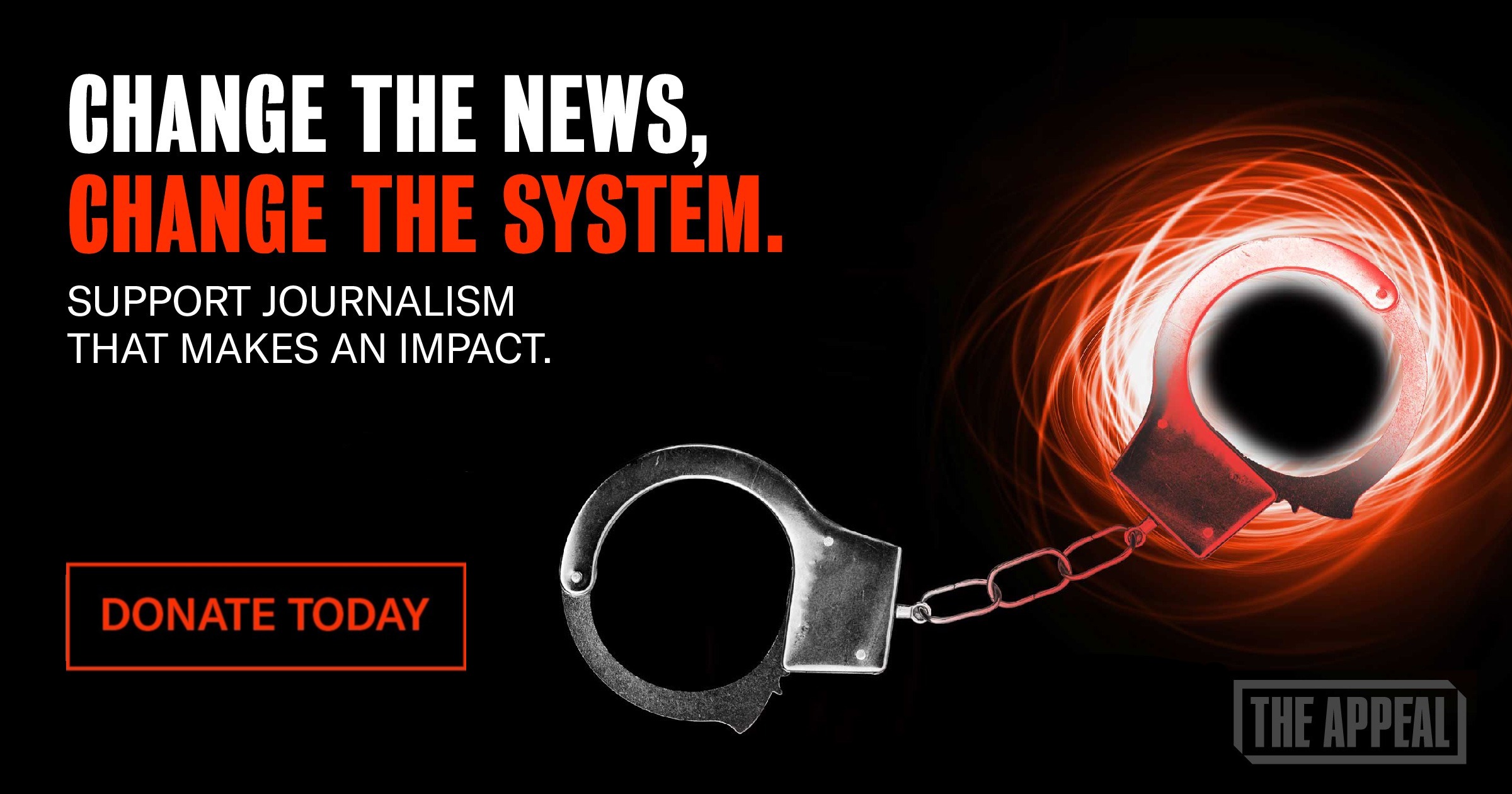ICE’s New Deputy Director Helped Oversee Louisiana’s Homeless Sweeps
Madison Sheahan’s Wildlife and Fisheries officers sent unhoused people to a New Orleans warehouse. What does that mean for the future?

As U.S. homelessness rates reach record highs, President Donald Trump has pledged to ban street camping, relocate unhoused people to privately-managed “tent cities,” and arrest anyone caught violating the new laws. But while Trump’s threats certainly sound draconian, they’re not exactly novel. In recent years, several states have organized increasingly harsh homeless sweeps—perhaps most typified by Louisiana, where the governor recently oversaw a possible model for the sort of mass relocation that Trump has promised.
Federal officials seem to be taking note. According to a local official who spoke to The Appeal, in early February, Homeland Security Director Kristi Noem quietly visited a warehouse where Gov. Jeff Landry had relocated nearly 200 homeless people, sometimes under threat of arrest. And in March, Trump appointed Madison Sheahan, a state official whose agency enforced Landry’s crackdown, to become deputy director for U.S. Immigration and Customs Enforcement (ICE). The U.S. Department of Homeland Security (DHS) did not respond to a request for comment.
Sheahan, who is 28, was appointed secretary of the Louisiana Department of Wildlife and Fisheries (LDWF) by Landry in 2023, though she had no background in conservation or ecology. She previously worked on Noem’s campaign for South Dakota governor and was executive director of the Republican Party there, where she worked on banning trans athletes from college sports. Otherwise, her qualifications are questionable: besides issuing rules for sawfish harvesting and letting military veterans hunt bears, Sheahan’s most relevant experience over the last year seems to be lending her officers to Landry to round up homeless residents.
Attorneys for the unhoused have now filed a class action suit against the state—including Sheahan’s LDWF—to block Landry’s crackdown. As the case unfolds in New Orleans’ civil district court, Louisiana’s situation could serve as a bellwether for how Trump 2.0 will address unsheltered homelessness—and even the detention of migrants.
Jesse Rabinowitz, communications director for the National Homelessness Law Center, called Sheahan’s promotion “really concerning.” He added that what’s happening in New Orleans is “a real-life example of what could happen on a larger scale.”
The sweeps by Louisiana state agencies are part of “how conservative electives can punish people living in more progressive parts of the state,” warned Rabinowitz. “They did it with migrants, and they’ve said they’re going to do it with homeless folks. And we have to believe them.”

Louisiana’s crackdown began during singer Taylor Swift’s October tour dates in New Orleans. In the days leading up to the concerts, Landry directed Louisiana State Police (LSP) and LDWF officers to “sweep” downtown encampments of hundreds of unhoused people, pushing them all into one designated area a few blocks away. The sweeps drew national attention. City council members and Mayor LaToya Cantrell condemned Landry’s actions. One council member’s chief of staff later said in an affidavit that, when she visited the government-run encampment, “one gentleman asked me where he could get a tent,” because state officers had thrown his away.
As a result, she said, “he got bitten by rats the night before because he did not have a tent to go inside.”
Lawyers representing unhoused people swiftly sued. But the ensuing court battle took a worrying turn in January, when the Louisiana Supreme Court ruled that cities cannot abridge the state’s police power. LSP can now conduct sweeps without following city ordinances, meaning they don’t have to provide sufficient warning beforehand. That ruling could signal to other red states that courts will let them send state agencies into blue cities, such as Austin or Nashville, and ignore any municipal-level protections in place.
A week after that ruling, LSP and DWF officers again descended on downtown New Orleans’ encampments. This time, they sent more than 100 people to a warehouse seven miles away called the “Transition Center.” Attorneys for the unhoused demanded another restraining order, but courts denied the request.
“Governor Landry’s interest in moving the encampments was to provide warm shelter and a place for the unhoused to be secure from potential harm during the Super Bowl and Mardi Gras,” a judge wrote.
The Transition Center sat in a former packaging warehouse alongside New Orleans’ industrial canal. While the press was not allowed in, photos shared from within the Center show rows of cots separated by black cloths, and some couches facing a television, in a warehouse with no eye-level windows. Residents reportedly received three meals daily and could leave freely, though neither a bus stop nor sidewalk sits near the site. Access was restricted to those with authorization.
Several service organizations worked in the warehouse. After initial difficulties, some employees say the remaining residents were satisfied with conditions. A medical worker told The Appeal he appreciated seeing patients consistently, and “we were able to get people healthier than when they arrived.”
Now that those events have finished, the warehouse has closed.
After the initial October sweeps, a judge ordered LSP and LDWF to “not destroy or dispose of the property of unhoused people without judicial process” and to provide notice of sweeps as set out in New Orleans’ municipal ordinances.
But the New Year’s Day truck attack that killed 14 people in New Orleans, including a sleeping unhoused person, seems to have changed the calculus. Within hours, Landry issued an executive order giving him emergency powers to “direct and compel the evacuation of all or part of the population, from any stricken or threatened area.” The following week, the Louisiana Supreme Court dissolved the preliminary injunction. One justice wrote that, in the wake of the Jan. 1 attack, the sweeps were “about public safety.”
Court affidavits show how the case has already emboldened police to criminalize people experiencing homelessness.
According to the lawsuit, 12 LDWF officers and “five or six” LSP troopers approached 32-year-old plaintiff Raymond Scott when the major sweeps began in January. Scott is unhoused and has already lost valuables during sweeps. Last summer, a city worker reached into his tent and took a treasured owl figurine Scott inherited from his great-grandmother, then disposed of it even as Scott “begged them not to take it,” according to a court affidavit he later filed.
“You have two choices,” a trooper said. “Come willingly, or we cuff you, detain you, and bring you to the Transition Center.”
Scott said he didn’t want to go.
“You know you can be arrested for being homeless now?” a trooper allegedly replied. Scott then said he wanted to call his lawyer.
Scott’s attorneys argue that the US Supreme Court’s 2024 ruling in Grants Pass v. Johnson does not permit Landry’s sweeps, since Grants Pass concerned whether arresting people for sleeping outside violates the 8th Amendment’s protections against cruel and unusual punishments. In this case, the attorneys allege Louisiana violated unhoused residents’ 4th and 14th Amendment rights.
Another resident, Michael Garner, asserts in the suit that seven or eight LSP troopers approached his camp and told him to pack up. When he asked if he could leave, a trooper said he was being detained.
“The troopers told me that I would not be free to leave until I was brought to the Transition Center,” Garner wrote. He says he packed everything he owned into a box and got on the bus. When he later tried to fetch his belongings—including his social security card, birth certificate, and a bicycle—“officials told me that they could not find the box.”
Last week, attorneys filed a motion to dismiss the suit voluntarily. The legal team declined to comment on that request, as the motion is pending.
Sheahan, who’s set to begin her role at ICE in the coming weeks, ran the LDWF when its officers conducted the sweeps. In a March 11 Fraternal Order of Police statement celebrating her promotion, Patrick Yoes, National President of the FOP, celebrated that she’d “established a Special Operations Group within the enforcement division” for events like the Super Bowl. According to a November Facebook post, state police officers trained LDWF’s new special-ops team. Sheahan also joined Landry and DHS Secretary Noem for a briefing on Super Bowl security measures when Noem visited in February.
LDWF agents typically enforce hunting, fishing, and boating regulations. An LDWF spokesperson did not answer questions about why the agency took part in homeless sweeps.
Advocates have decried the sweeps and “transition center” as both cruel and ineffective. But at the state level, officials have celebrated their success.
“We think this is absolutely going to be looked at as a success, because we were able to get people out of harm’s way just weeks after a terror attack in that same area,” a spokesperson for the Louisiana Governor’s Office of Homeland Security and Emergency Preparedness (GOHSEP) told The Appeal. The state closed the Transition Center on March 21.
The spokesperson said that, from a peak of 183 people, 108, or about 60 percent, received permanent housing by the time the center closed.
An additional 59 people left on their own, while 15 others moved into a different shelter downtown. The center’s final costs could exceed $17.5 million.
But some housing advocates say the sweeps undermined the city-level housing efforts that have been ongoing since 2023. Those programs have housed more than 822 people at a much lower cost per person. Critics also say the warehouse sweeps disrupted contact between unhoused people and their case workers and service providers. The National Homelessness Law Center’s Rabinowitz stressed that the only real fix is affordable housing.
“There’s consensus that housing solves homelessness, and throwing people in jail and forcing homeless people into camps is not the solution,” he said. “But the people that are put in charge don’t seem to be motivated by helping people. They seem to be motivated by this desire to police and punish people for struggling in a country where a lot of people are struggling to make ends meet.”
